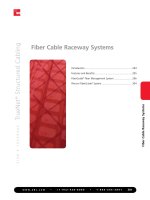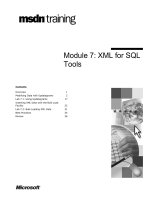Tài liệu Innovative Installation Techniques for Fiber Drop Terminals docx
Bạn đang xem bản rút gọn của tài liệu. Xem và tải ngay bản đầy đủ của tài liệu tại đây (304.4 KB, 4 trang )
WHITE PAPER
Innovative Installation
Techniques for Fiber
Drop Terminals
As fiber-to-the-premises (FTTP) deployments increase, innovative methodologies
are being developed to make the installer’s life easier. In the outside plant – from
the central office (CO) to the optical network terminal (ONT) at each subscriber
premises, new techniques and better products are helping to streamline the
process of offering triple-play services to the consumer.
Making the FTTP network as modular as possible, with easy plug-and-play
options, provides benefits, both during initial installation and throughout the
operational life of the network. ADC has achieved a leadership position in
developing, testing, and delivering products that ensure flexibility, reliability,
and scalability for today’s FTTP initiatives.
This paper addresses one area in which ADC heard the frustrations of FTTP
installers and developed a unique product that alleviates those frustrations.
The new multiport service terminal (MST) universal mounting bracket is
designed to save time, reduce complexity, and streamline the process of
mounting MSTs for installing drop cables in any FTTP deployment.
Adapting to the situation
ADC developed a universal mounting bracket for installing
MSTs. The most obvious benefit of the universal mounting
bracket is its compatibility to any mounting scheme. It easily
mounts to poles, in pedestals, in hand holes, or on strands.
Because the bracket adapts for all mounting situations, MST
installations are accomplished in less time and with reduced
complexity. It also eliminates the logistics of ensuring brackets are available for
each type of mounting technique. Since it adapts to every mounting situation,
there is no possibility of the installer suddenly discovering the appropriate
bracket is not available.
Innovative Installation Techniques
for Fiber Drop Terminals
Pedestal with
Multiport
Service
Terminal
Fiber
Distribution
Hub
Aerial
Multiport
Service
Terminal
Hand-Hole with
Multiport
Service
Terminal
Drop
Cables
Splice
Case
Drop
Cables
Fiber OSP
Cable from CO
Multiport
Hardened Connector Architecture
Page 3
The snap-in/snap-out feature of the universal bracket
makes the MST readily available for drop cable
connections or re-connections. Its rigid plastic structure
– using the same material as the MST – ensures it can
withstand the same environmental exposures, including
contracting and expanding with temperature variations.
A single, reinforced latch enables easy MST detachment
from the bracket, while an audible engagement assures
the MST is correctly snapped into place and properly
seated in the bracket’s cradle. The through holes align
with the terminal and additional holes are available for
edge mounting. Slots are provided for securing with tie
wraps and Deltec straps.
Whether mounting on a pole, in a pedestal, in a hand
hole, or on a strand, the universal mounting bracket
reduces cost, time, necessary logistics, and the complexity
of traditional mounting options.
Pole mounting
Mounting MSTs on poles
typically required a separate
mounting bracket costing
$12 to $15. Besides
additional cost, there were
several additional issues
related to pole-mounting.
For example, part of the
installation technique
required the installer to hammer screws directly through
holes in the terminal. Missing the screw meant hitting
the terminal – possibly damaging the connector or cable.
Placing the MST at risk in order to mount it on a pole is
not a desirable option.
Another issue was in the logistics of ensuring the correct
bracket was available, since the brackets were ordered
separately. In some instances, installers would climb
up the poles, discover they were missing the correct
mounting bracket, and simply hammer the screws
directly through the holes in the terminal – again, risking
damage to the terminal.
The MST universal mounting bracket enables simplified
pole mounting without risk to the terminal. The bracket
is mounted separately with two lag bolts or screws that
can be hammered in place without risking damage to
the terminal, cable, or OptiTap™ adapters. The heads
of the bolts or screws fit into recessed areas where they
cannot interfere with the MST. Once mounted in place,
the terminal simply snaps onto the universal mounting
bracket with an audible snap to ensure the technician it
has seated properly.
ADC’s universal mounting bracket is integrated with the
terminal design and shipped together as one unit. This
eliminates the need for incremental inventory in terms of
separate additional mounting brackets and saves about
$15 per installation.
Pedestal mounting
Mounting MSTs in pedestals
would seem a relatively simple
proposition. Prior to the
introduction of the universal
mounting bracket, the terminal
was semi-permanently affixed
to the pedestal with nuts and
bolts. Often, consideration for
mounting the pedestal would
need to include which pedestal
was being used, adding another
layer of complexity and cost to FTTP deployment. Should
maintenance to the pedestal or terminal be required,
removing the terminal was inconvenient, often adding
unnecessary time and effort to a simple maintenance
procedure.
The universal mounting bracket provides flexibility in
allowing MST to snap in and out of the pedestal in a
matter of seconds and not minutes. The bracket itself
is semi-permanently affixed to the pedestal or pedestal
center panel using two small screws.
In a pedestal mounting environment, the universal
mounting bracket removes complexity and cost from
FTTP deployments.
Hand hole mounting
The same universal bracket can
be used below ground in hand
holes that currently use two
mounting techniques – the swing
arm and waffle bracket. The
swing arm is a separate bracket
that swings up from the hand
hole for terminal mounting. The
waffle bracket hangs on the side
of the hand hole and lifts out for
mounting the terminals.
In some cases, either no mounting technique was used
or installers neglected to order any brackets, so terminals
were simply placed in the bottom of the hand hole. Since
hand holes can often fill with water, this is not a desirable
method. Even with brackets, when it is time to connect
drop cables to the terminals, they must be removed from
the hand hole for cleaning and drying before attaching
the cables.
ADC’s universal mounting bracket is compatible with
both the swing arm bracket and the waffle bracket.
It provides hanger loops that enable it to be hung on
any existing hanger bracket. The universal bracket can
also be anchored to the lip of the hand hole, just below
the cover, with two self-threading screws. Regardless
of what mounting technique is used, terminals are
easily snapped in and out of the universal bracket
for connecting drop cables.
Innovative installation techniques for fiber drop terminals
WHITE PAPER
By eliminating the need for separate waffle brackets or swing arms, installers save $17 to $25 per
installation. The single latch removal feature and simple snap installation allows the terminal to be
removed easily from the hand hole and easily re-installed.
Strand mounting
When mounting to a pole is not possible due to a lack of space, strand
mounting is the common alternative. During an installation, the MST universal
bracket is easily strand mounted using standard materials already available
to the installer. A separate strand mounting bracket can sell for as much as
$15 and, again, may not always be readily available or even the proper one
for a particular deployment. The same universal bracket that mounts easily
to a pole or into a hand hole – and is shipped with the MST – is contoured for strand mounting
with standard heavy-duty tie wrap fasteners or Deltec.
The universal bracket is also compatible with stand-off tools used for traditional strand mounting.
The bracket can be secured to either fiber-optic or copper cable. MST placements are accomplished
in a variety of ways, depending on the deployment, and may even be deferred until any point in the
future. In the advanced termination system (ATS), for example, installers opt to place a multifiber
connection (MFC) at the tethered access point (TAP), enabling them to go back at any time in the
future and install an MST using a plug-and-play approach.
Compatibility, ease, and lower cost
The key advantages to using the MST universal mounting bracket for pole, pedestal, hand hole,
or strand mounting are worth mentioning again:
The bracket was developed by ADC as a direct result of customer feedback about issues they were
experiencing in the field with MST mounting. The design concept evolved as an answer to these
deployment issues – and the result is the MST universal bracket – simplifying MST mounting even
where legacy equipment already exists. By reducing MST installation time and complexity, ADC has
again helped bring the benefits of fiber directly to the end user.
OptiTap
™
is a trademark of CCS.
Website: www.adc.com
From North America, Call Toll Free: 1-800-366-3891 • Outside of North America: +1-952-938-8080
Fax: +1-952-917-3237 • For a listing of ADC’s global sales office locations, please refer to our Website.
ADC Telecommunications, Inc., P.O. Box 1101, Minneapolis, Minnesota USA 55440-1101
Specifications published here are current as of the date of publication of this document. Because we are continuously
improving our products, ADC reserves the right to change specifications without prior notice. At any time, you may
verify product specifications by contacting our headquarters office in Minneapolis. ADC Telecommunications, Inc.
views its patent portfolio as an important corporate asset and vigorously enforces its patents. Products or features
contained herein may be covered by one or more U.S. or foreign patents. An Equal Opportunity Employer
105182AE 8/07 Original © 2007 ADC Telecommunications, Inc. All Rights Reserved
• Same bracket can be pole, pedestal, hand hole,
or strand mounted
• Eliminates the need for more inventory and
additional materials in the field
• Reduces or eliminates the use of extra fasteners
• Uses materials already available to the installer
• Minimizes the risk of damage to the MST
• Saves cost of additional mounting brackets
($12 to $25 per installation)
• Easily engages/disengages MST with an audible
snap engagement and single latch release
• Eliminates logistics – no need to order
other brackets
• Rigid plastic construction – same as MST – will
expand or contract with MST
• Stands up under high vibration or stress created
by cables placed in the MST









